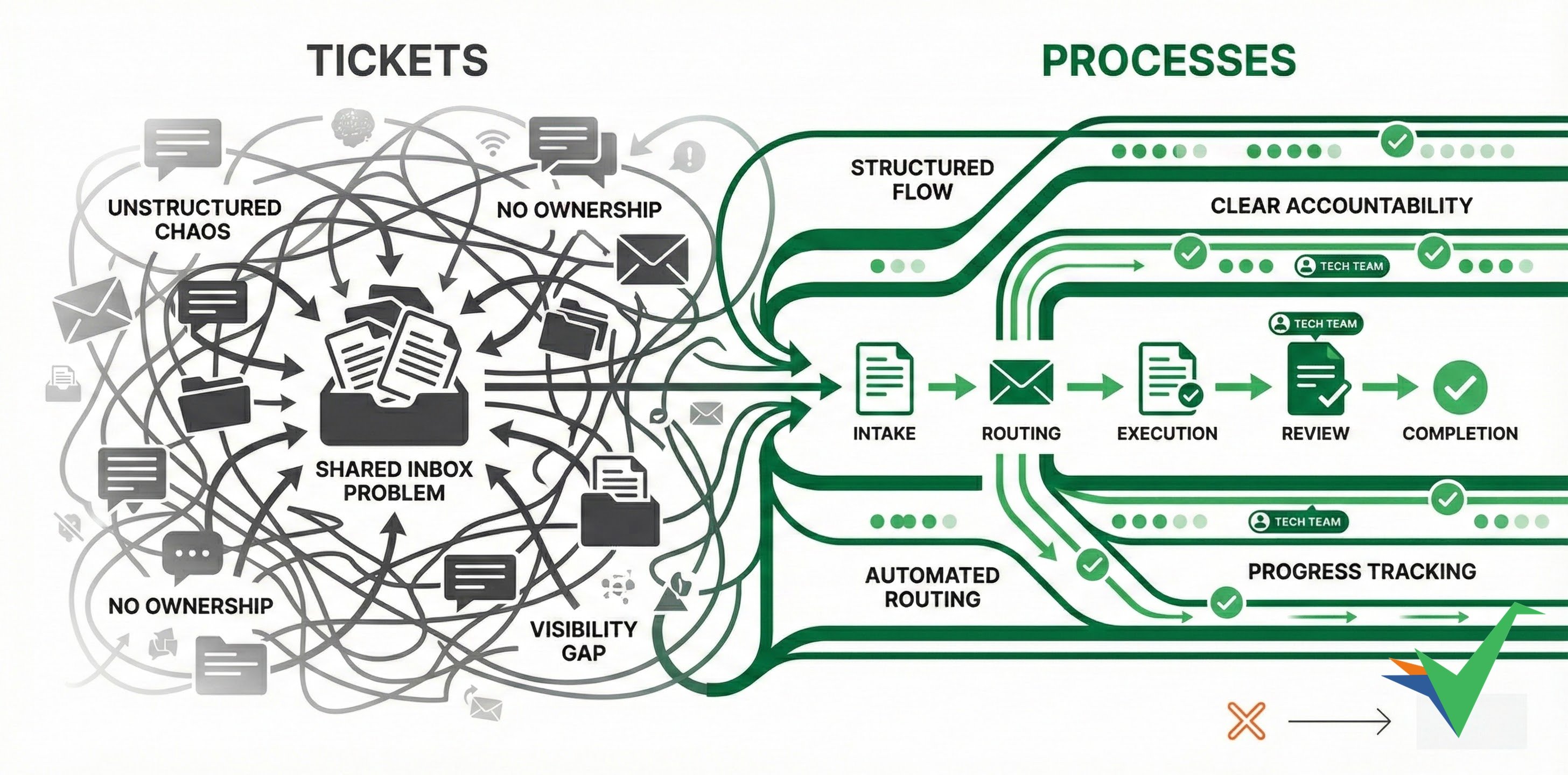Process Improvement > What is process improvement?
Tickets vs. Processes

Ticket-driven workflows often work like separate conversations started in different ways:
- Email to a specific address for formal requests
- A new social media conversation for public inquiries
- A phone call for urgent matters
- A chat message on a website or app for immediate assistance
The shared inbox problem
Shared inboxes suffer from the same fundamental flaws as ticket systems - they’re unstructured chaos masquerading as organization. Teams dump emails into a shared inbox hoping someone will handle them, but what you get is:
- No structured data: Just walls of text with information buried in email threads
- No accountability: “Someone” will handle it (but who? when?)
- No visibility: Is this being worked on? Who knows?
- No consistency: Each person handles requests their own way
- No improvement: Same problems repeat because there’s no process to optimize
Both tickets and shared inboxes are fundamentally about opening and closing something with minimal structure - they’re Band-Aids on broken processes.
The typical ticket workflow follows this sequence:
- Managing the queue: An incoming request waits to be processed in order.
- Initial check: An agent decides if they can handle it or if it needs a specialist team.
- Gathering information: Collecting more details if the initial info isn’t enough for resolution.
- Solving the issue: Responding and providing a solution to close the ticket.
- Optional check for root cause: Looking into underlying problems that might need fixing in the product.
- Optional feature consideration: Deciding if the issue suggests possible product improvements.
- Optional help docs update: Checking if documentation needs updating based on the question.
This model often has several operational downsides:
- Steps 5-7 are often skipped due to time constraints or lack of process enforcement.
- Customers can’t easily see the ticket status or progress, creating uncertainty.
- Manual follow-up is needed if responses are slow, increasing administrative overhead.
- Service quality depends heavily on the individual agent handling the ticket, creating inconsistency.
Tallyfy process-driven workflows turn ticket handling into structured processes with clear steps and accountability. Key features include:
- Structured intake: Using standard forms for initial request details and categorization for consistency.
- Routing before review: Automatically sending requests to the right teams based on type for efficiency.
- Using help docs automatically: Applying knowledge base info systematically for consistent responses.
- Involving other teams: Clearly defining when other departments get involved for seamless collaboration.
- Linking to improvement processes: Connecting issues systematically to product improvement workflows for continuous enhancement.
This approach transforms reactive ticket handling into proactive workflow management.
- Consistent steps: Standard handling for all interactions ensures uniform quality.
- Ensuring follow-up: Automated reminders prevent missed steps and maintain accountability.
- Processes that can grow: Clear ownership and next steps enable easy scaling as volume increases.
- Clear progress tracking: Visual status updates keep everyone involved informed of current state.
- Customer visibility options: Optionally showing process status to external people for transparency.
- Regular improvement cycles: Structured review of recurring issues drives systematic product improvement.
- Improving help docs: Systematically reviewing if help documentation is adequate for self-service.
These advantages create more reliable, scalable, and customer-friendly support operations compared to traditional ticket-driven approaches.
Process Improvement > Understand process flow without flowcharts
How To > Improve processes effectively
Miscellaneous > Tallyfy vs. Projects
Was this helpful?
- 2025 Tallyfy, Inc.
- Privacy Policy
- Terms of Use
- Report Issue
- Trademarks